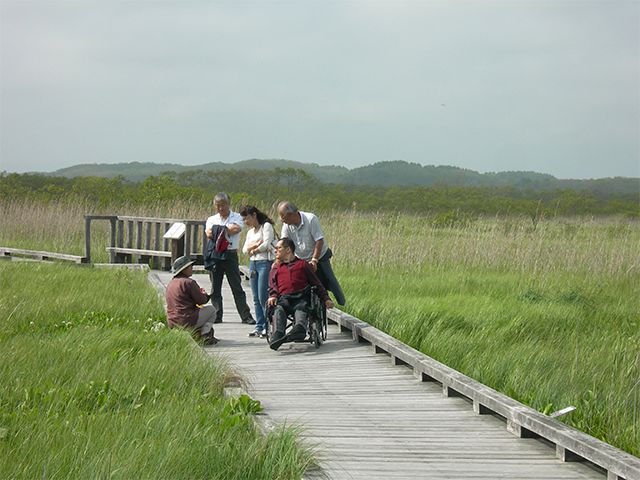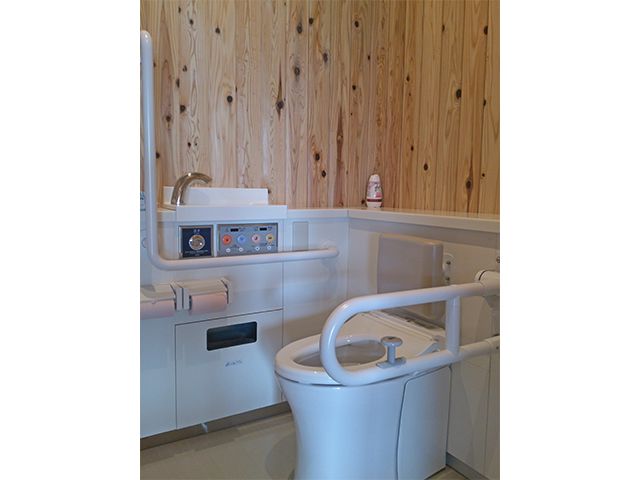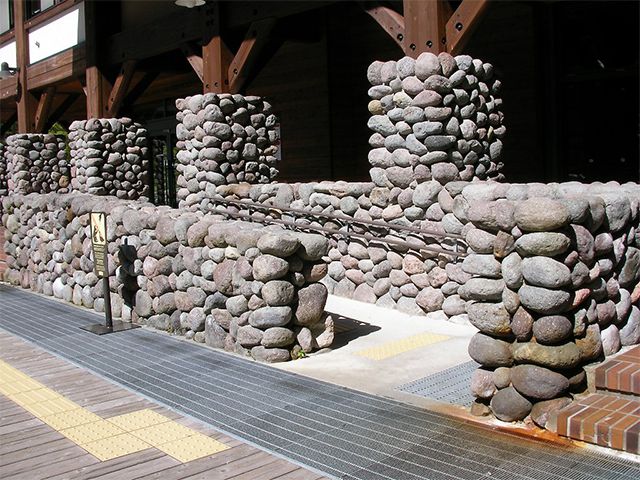- MOE
- National Parks of Japan
- Definition of National Parks
- Protection and Use

National parks aim to protect Japan's exceptional natural sites and preserve them for future generations so the latter can experience these with the same sense of wonder and joy as our generation.
Accordingly, the protection and use of the natural environment is managed on different levels.
Moving Forward in Step with the Changing Times
As apparent from the history of the national parks, areas designated as national parks originally consisted of large, primeval, natural landscapes that have been cherished since ancient times (including famous locations, historic sites, traditional sightseeing spots and mountain ranges). However, as time went on, areas situated near residential neighborhoods and well suited for recreational purposes were also added.
From the late 20th century, the definition of exceptional natural landscapes diversified, various new areas were designated as national parks including landscapes containing valuable natural ecosystems, underwater landscapes such as coral reefs, natural sites providing a habitat for wildlife, and vast marshlands.
At the same time, a large number of problems emerged including excessive use of certain locations, the destruction of secondary natural environments such as grasslands, feeding damage from large wild animals such as Japanese deer, and disruption of the ecosystem by alien species.

Crown-of-thorns Starfish Removal Work

Mountainto Climbers Generates Excitement
For this reason, each area is governed by various usage regulations, and extensive efforts are made to preserve the natural environment, including the cooperation of many volunteers.
Moreover, changes in social-economic conditions have triggered a downtrend in national park visitors and thus undermined tourism and other local industries that have long been a source of revenue for the national parks. Consequently, some areas are facing difficulties and struggle to reasonably maintain and manage park facilities.
Such circumstances have increased the importance of cooperative maintenance and operation that draws on collaboration from various regional parties for the promotion of national park protection and usage.
National park can give visitors a profound appreciation of natural landscapes, while at the same time strengthening their resolve to help preserve valuable natural resources for future generations.
Protection of Nature and Management of Usage
National parks are managed using various structures that derive from the Natural Parks Act.
(1) Management and Operation Plan
The policies governing the management of national parks are formulated in a Management and Operation Plan for each park. The plan promotes the protection of the natural environment and appropriate usage by prescribing regulations and rules tailored to the local conditions of each park, establishing facilities on park grounds, organizing opportunities to learn about nature, and promoting the protection and appropriate usage of natural resources.

(2) Regulations Governing Development Projects
Regulations have been established to govern activities such as (1) newly constructing, renovating or expanding building structures that may potentially alter the natural environment and landscape of national parks, (2) felling trees or bamboo, (3) removing earth and stones, and (4) capturing animals. The scope and details of the regulations vary based on the zone designation in accordance with the Park Plan (Protection Regulation Plan).
(3) Protection of Animals and Plants
Natural landscapes comprise a large number of elements that together make up an ecosystem that is essential to the survival of the animals and plants where they have their habitat and breed in these areas. National parks preserve the diversity of their ecosystems by putting restrictions on unauthorized hunting of designated animals or picking of designated plants within special zones.

(4) Regulated Utilization
Amid growth in national park visitors, the Minister of the Environment established Regulated Utilization Areas in 2002 with the aim of removing potential obstacles for the preservation of primeval nature, landscapes and biodiversity. These areas aim to maintain the natural landscapes and promote appropriate usage by restricting entry to certified people.
(5) Motorized Vehicle Prohibited Area
To prevent damage from snowmobiles and off-road vehicles to the habitat or breeding areas of vegetation and wild flora and fauna, the Minister of the Environment has designated Special Zones in national and quasi-national parks, where the use of such vehicles is prohibited.

(6) Nature Restoration
With the aim of proactively restoring the health of ecosystems that have been damaged in the past, various nature restoration projects are being conducted. Some examples include the restoration of marshlands by reversing previous straightened rivers to meanderingcourses, the restoration of mudflats in coastal areas near cities, and forest creation.

(Sekisei Lagoon Nature Restoration Project).
(7) Scenic Landscape Protection Agreements
Agreements for the protection of natural landscapes have been concluded with landowners and other vested parties with respect to the natural environment located inside National and Quasi-National Parks where there is a risk that efforts are not being made to protect the landscape owing to insufficient management on the part of the landowners and other vested parties. These agreements allow the management of natural landscapes to be undertaken on behalf of these landowners and other vested parties.
(8) The Special Private Land Purchase System
A significant portion of National Parks and National Wildlife Protection Areas and other areas consists of privately owned lands. Where the privately owned land constitutes an exceptional natural site, it may be purchased by the Ministry of the Environment through an application submitted by the owner.
(9) Ecosystem Maintenance and Recovery Work
As exemplified by worsening feeding damage from deers to natural vegetation and from crown-of-thorns starfish to coral communities, as well as the replacement of native animals or plants by invasive species, many regions have witnessed cases where conventional regulatory measures alone have proved insufficient to protect natural landscapes. In an effort to maintain the exceptional natural environment of national and quasi-national parks, several proactive initiatives are conducted to capture offending animals, remove invasive species, and protect natural vegetation and coral communities from feeding damage.
(10) Regulation of Private Cars (Measures to Streamline Vehicle Use, etc.)
National parks allowed unlimited car access in the past, but this led to problems in the form of parking demand in excess of capacity on non-working days and resulting adverse impact on the surrounding natural environment, which is vulnerable to exhaust gases. In 1974, the Minister of the Environment introduced regulations for private cars, which restricted access based on region and period.
(11) Visitor Facilities
In addition to protecting nature, national parks also serve a critical function in promoting a deeper understanding of the importance of nature and providing a place where people can come into contact with nature while engaging in health-oriented or recreational activities. To ensure national park visitors can comfortably experience nature, the Ministry of the Environment provides and maintains various facilities such as visitor centers, nature trails, restrooms and observatories, and thus continually promotes the appropriate use of national parks.
(12) Adoption of Universal Design
Universal design refers to "the design of products and environments to be usable by all people, to the greatest extent possible, without the need for adaptation or specialized design," and has been promoted as a replacement for the barrier free concept, which focuses on removing barriers.
In accordance with the Natural Park, Etc. Facility Technical Guidelines (revision August 2015) enacted in July 2013, the national parks aim to ensure all visitors can "enjoy the beauty of the exceptional natural landscapes." In addition to maintaining and improving visitor facilities, the national parks implement various initiatives to support a comprehensive universal design system by emphasizing soft services (lending of assistive equipment, care support, proper provision of information, etc.).
The national parks are maintained in accordance with the following principles.
(1) Find ways to have visitors enjoy the parks' beauty and resources
(2) Help visitors select activities or information that match their skills and interests, and conduct related safety measures
(3) Provide hard infrastructure that does not harm natural resources; where difficult to provide hard infrastructure, compensate through soft services such as lending of assistive equipment
(4) Select materials and construction methods that take into account natural challenges such as wind and snow or salt erosion, and maintain and manage these appropriately
(5) Provide soft services that accommodate the needs of a wide range of visitors; continually make improvements where necessary
Examples of Region-specific Initiatives
The barrier-free wooden paths either feature a consistent width or certain wider sections that allow wheelchair users to pass by each other.

Width of 2.0 m (Shiretoko National Park)

1.8 m (Kushiroshitsugen National Park)
Multipurpose toilets feature sufficient maneuvering space for a wheelchair, handrail, baby crib, ostomate facilities, etc.

(Chubusangaku National Park)

(Aso-Kuju National Park)
A slope was established in front of the entrance to facilitate entry for wheelchair users, seniors, and adults accompanied by children.

(Chubusangaku National Park)

(Kirishima-Kinkowan National Park)
The universal design is outlined in pamphlets and the like.
National Garden* and National Park Universal Design Project
In 2015, the Ministry of the Environment launched the National Garden / National Park Universal Design Project, which summarizes ideas aimed at enabling a wide range of people (seniors, people with disabilities, stroller users, foreigners, etc.) to comfortably spend time at national gardens and parks, and divides these into short and long-term initiatives, both in terms of hard infrastructure and soft services. The project invited universal design experts to inspect actual facilities and provide advice, thus ensuring that the ideas put forward are aligned with actual conditions on the ground.
*National garden:Japan has four national gardens, which are directly managed by the government and made accessible to the general public. These include the Kokyo Gaien National Garden, the Kyoto Gyoen National Garden, the Shinjuku Gyoen National Garden (all formerly belonging to the Imperial Family), as well as the Chidorigafuchi National Cemetery, which is a cemetery park that shares some characteristics with regular parks.


